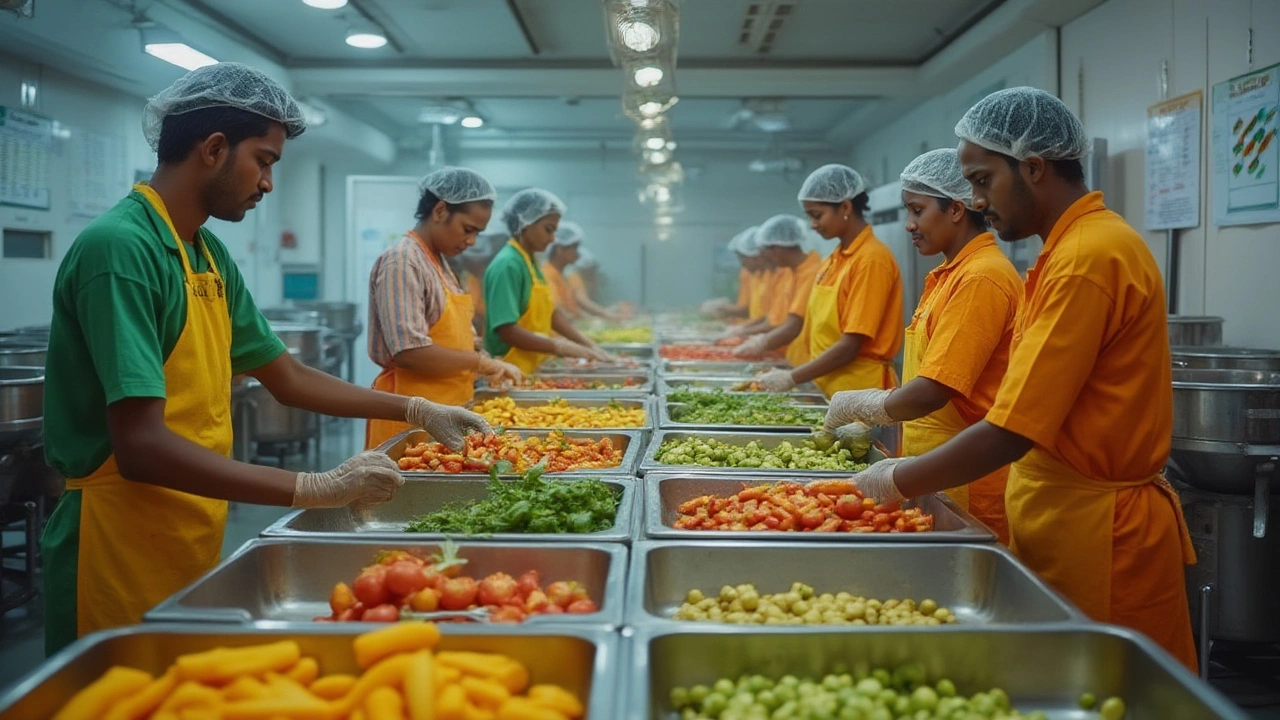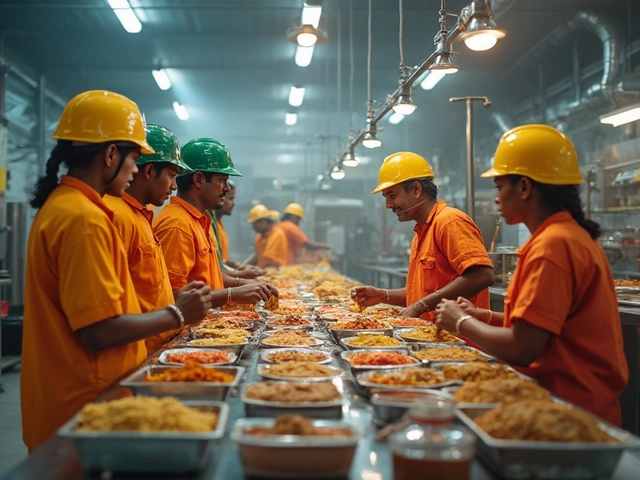If you’ve ever visited a food factory, you know the pressure there: cleanliness must be top-notch. But there’s more to it than slapping on a hairnet and scrubbing down tables. Food processing has borrowed a wild card from the world of Japanese manufacturing—something called 5S. It might sound like another corporate buzzword, but in real kitchens, 5S is a lifesaver—and sometimes a business-saver too. The difference between a spotless, organized production line and a chaotic, mess-prone one is often the difference between keeping a contract or scrambling for explanations when auditors come knocking. 5S isn’t just neatness for neatness’s sake; it’s about safer food, higher efficiency, and, not to get too dramatic, protecting your company’s neck.
The Origin and Core Principles of 5S in Food Processing
5S started far from the kitchen—in Japanese car factories in the 1950s. But pretty quickly, people realized these five simple steps (all starting with ‘S’ in Japanese!) can transform any messy environment into a well-oiled operation. In food processing, the 5S steps are: Sort, Set in order, Shine, Standardize, and Sustain. These may sound straightforward, but their impact on food safety and efficiency is massive.
‘Sort’ is about tossing out anything you don’t need—think old spatulas, expired oils, or broken thermometers. If it’s not useful, out it goes. ‘Set in Order’ means every tool, ingredient, and piece of kit has its place, labelled and within easy reach. Then comes ‘Shine,’ which means scrubbing every surface, nook, and cranny until it practically gleams. ‘Standardize’ takes things further: setting rules so everyone does things—like cleaning or arranging ingredients—the same way every single time. Last is ‘Sustain,’ which, put simply, means turning all the earlier steps into daily habits.
The reason 5S works so well in food processing is because cross-contamination, spoilage, and slip-ups are often tied to a messy, disorganized space. In the UK, the Food Standards Agency found that 1 in 6 outbreaks in food plants involve cleaning or organizational mistakes. That’s a wild stat if you think about it. Factories that use the 5S system consistently score higher in food safety audits, not just in the UK but over in Germany and Japan too.
Step One: Sort—Clearing the Clutter
Let’s talk about ‘Sort’—the step where you finally get ruthless with clutter. In most food plants, a pile of extras builds up: boxes of unlabeled spice, five kinds of ladles, trays with missing pieces. When you hold onto everything “just in case,” you actually make mistakes way more likely. In one Lancashire bakery I visited, they found thirty-two different scoops hanging around—twenty-seven of which should’ve been binned.
So, you start by sorting every tool, ingredient, and document and ask: do we use this every day? Is this essential, or just taking up space? What’s broken or expired? Workers should get involved—often, they know what’s useful and what’s a hazard. The best factories use red tags to label things to be tossed or relocated, and set up ‘red tag zones’ where cast-offs go before their fate’s decided. This way, nothing clutters the main workspace.
Here’s a fun fact: food plants that get strict about sorting see lower accident rates and less product loss. A 2022 survey across the UK, Ireland, and the Nordics (by the British Frozen Food Federation) reported that food plants who adopted 5S cut lost-time accidents by up to 34%. Less clutter, less tripping, less confusion. It’s not rocket science, but it works wonders.
The most common sorting mistakes? Hoarding. Staff or managers thinking, “But we might need this one day!” The best way to avoid that is regular audits and a clear system for deciding what stays and what goes. In my own kitchen at home, Arjun helps—if my son can spot out-of-date tins, factory workers can definitely spot a dusty old sieve that’s past its prime.
Step Two: Set in Order—Everything Has a Home
Now you’ve decluttered, it’s time for Set in Order. This step is organization on steroids. In food plants, losing a thermometer isn’t just annoying; it can stop production or risk contamination. With Set in Order, every item gets a spot: knives on shadow boards, flour bins labelled and off the floor, scoops hung by the mixing station… even first aid kits have an obvious home.
Many plants use visual tools—labels, colour codes, pictures—to help staff know what belongs where, even if they don’t speak much English. And it’s not just fancy graphics: a simple laminated sign on a fridge door can mean the difference between safe ingredients and a ruined product run. Consistency is the magic word here. If you visit a Walkers crisp factory and grab a scoop, you should always know exactly where to put it back, even blindfolded. (OK, not literally, but you get what I mean.)
Organisation saves time, too. A study by the Institute of Food Science & Technology in 2023 showed UK food facilities using Set in Order sliced an average of 18 minutes per shift off their prep time. For a large plant, that’s hundreds of hours saved—time that can go into quality checks or more batches. Even in a small café, shaving five minutes off a sandwich run can save your sanity at rush hour.
One key point: involve everyone in the system, from the morning cleaner to the night shift packers. People who use the equipment day-in, day-out know the fastest routes and the sneakiest storage spots. When you give them input, the whole team buys in, and that’s when you see real change stick.

Step Three: Shine—Deep Clean Like You Mean It
Shine isn’t just about making surfaces gleam for a health inspector. In the food industry, a little grime can mean a full product recall and angry customers. Shine means scheduled, deep cleaning—yes, every single shift. Cross-contamination hides in cracks, under equipment, and inside corners everyone forgets. You’d be shocked at what builds up behind an ice cream machine.
The best-performing plants break cleaning tasks into daily, weekly, and monthly checklists. One Manchester cheese processor uses bright, waterproof cleaning schedules secured over each sink, so nobody forgets whose job it is. It’s not optional; it’s a signed promise. Staff rotate cleaning duties to keep everyone sharp and avoid the “that’s not my job” trap.
Tech is stepping in too—some bakeries use UV lights to reveal what’s been missed. Others use ATP (Adenosine triphosphate) swab tests that show, in seconds, if a surface is microbe-free. A publicly available 2022 Food Standards Agency audit found surfaces left “clean-looking” by hand wipes still held dangerous bacteria, underlining why Shine matters way more than just appearances.
You can’t just clean the easy spots. Tricky areas—mixers, inside conveyor guards, under fridges—need love too. And don’t forget gear: cleaning brushes and cloths can themselves spread contamination if not changed out regularly. Factories who build ‘Shine’ into their compliance routines rarely face complaints or recalls. It’s that simple.
Standardize and Sustain—Turning Good Habits Into Second Nature
The first three S’s make a world of difference, but without the last two, they slip away. ‘Standardize’ is about creating foolproof routines: documented cleaning, consistent layout, checklists for every crew, every shift. It stops the morning crew arguing with the afternoon crew about “how we do things here.” These routines become part of onboarding, so even new starters know what’s expected from day one.
Mistakes in standardization often crop up when processes change, like when you get a new bit of kit or a sudden rush order. The smartest teams update their systems the second anything shifts, so everyone is calibrated. A table like the one below highlights how standardizing each S can be tracked—not just assumed:
| 5S Step | How It’s Standardized | Frequency |
|---|---|---|
| Sort | Quarterly audits, red tag areas | Every 3 months |
| Set in Order | Visual labelling, shadow boards | Monthly updates |
| Shine | Cleaning logs, random ATP tests | Daily/Weekly |
| Standardize | Documented SOPs, posted schedules | Each shift |
| Sustain | Team meetings, training refreshers | Every month or at process change |
Now, ‘Sustain’ is a bit of a mindset game. It’s easy when managers are watching. Harder on a Friday at 6pm when everyone wants to clock off. The secret is involving staff at every level. Recognition for good habits—some plants give “5S Champion” shout-outs in weekly meetings or hand out lunch vouchers for perfect cleaning records. Peer inspection works, too: when staff rate each other’s areas, standards stay sharp without managers having to nag.
If a team starts slipping, don’t wait: a quick training booster or a round of friendly competition can restart momentum. Turning 5S into a badge of pride, not just a checklist, keeps things sustainable even as staff rotate or grow.
Why 5S Makes Food Processing Safer and Smarter
So, does all this really make a difference? You bet it does. Factories that follow the 5S method report fewer accidents, lower downtime, and, most importantly, fewer food safety scares. The UK’s Food and Drink Federation found plants using strong 5S routines had a 23% reduction in product recalls over a five-year window. That’s millions in savings—and fewer unpleasant emails to angry supermarkets.
Staff say morale improves, too. When workspaces are tidy, routines are predictable, and everyone knows what’s expected, people actually want to show up. In turn, that lowers staff turnover—a big deal in an industry where training new folks is expensive and time-consuming.
Here are some quick-fire practical tips if you want to try 5S in your own food business:
- Start small—focus on one workstation, section, or shift at first. Learn what works and tweak as you go.
- Give staff a say. Include front-line workers in making the rules and picking what stays or goes—they’ll spot things managers miss.
- Invest in visuals. The clearer your signs and labels, the less re-training and confusion you’ll face as staff turn over.
- Pull data from your routines. Even simple tick-sheets can show you which steps slow things down or where errors creep in.
- Celebrate wins. Whether it’s shaving time, passing inspections, or spotless workspaces, reward it—even if it’s just a mention in the staff WhatsApp group.
Modern food processing isn’t just about big machines and fancy ingredients. It’s about small, consistent habits—things like 5S—that transform daily chaos into something manageable and safe. The 5S in food processing philosophy is catchy because it works: it makes factories cleaner, teams more engaged, and puts businesses on the right side of the inspectors every time. At home, Arjun sometimes asks why my spice rack is suddenly labelled and tidy. I just grin—it’s the same trick the pros use, after all.






Write a comment